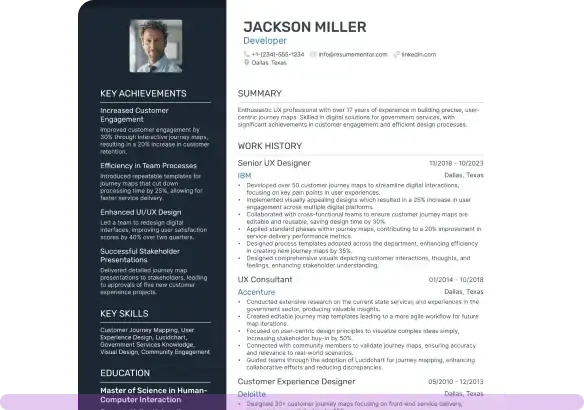Emergency Medical Technician Resume Examples

Mar 25, 2025
|
12 min read
Writing an effective emergency medical technician resume is essential to save your career. Highlight your EMT skills and experience so your resume does not fall into code blue. Stand out in the fast-paced medical field.
Rated by 348 people
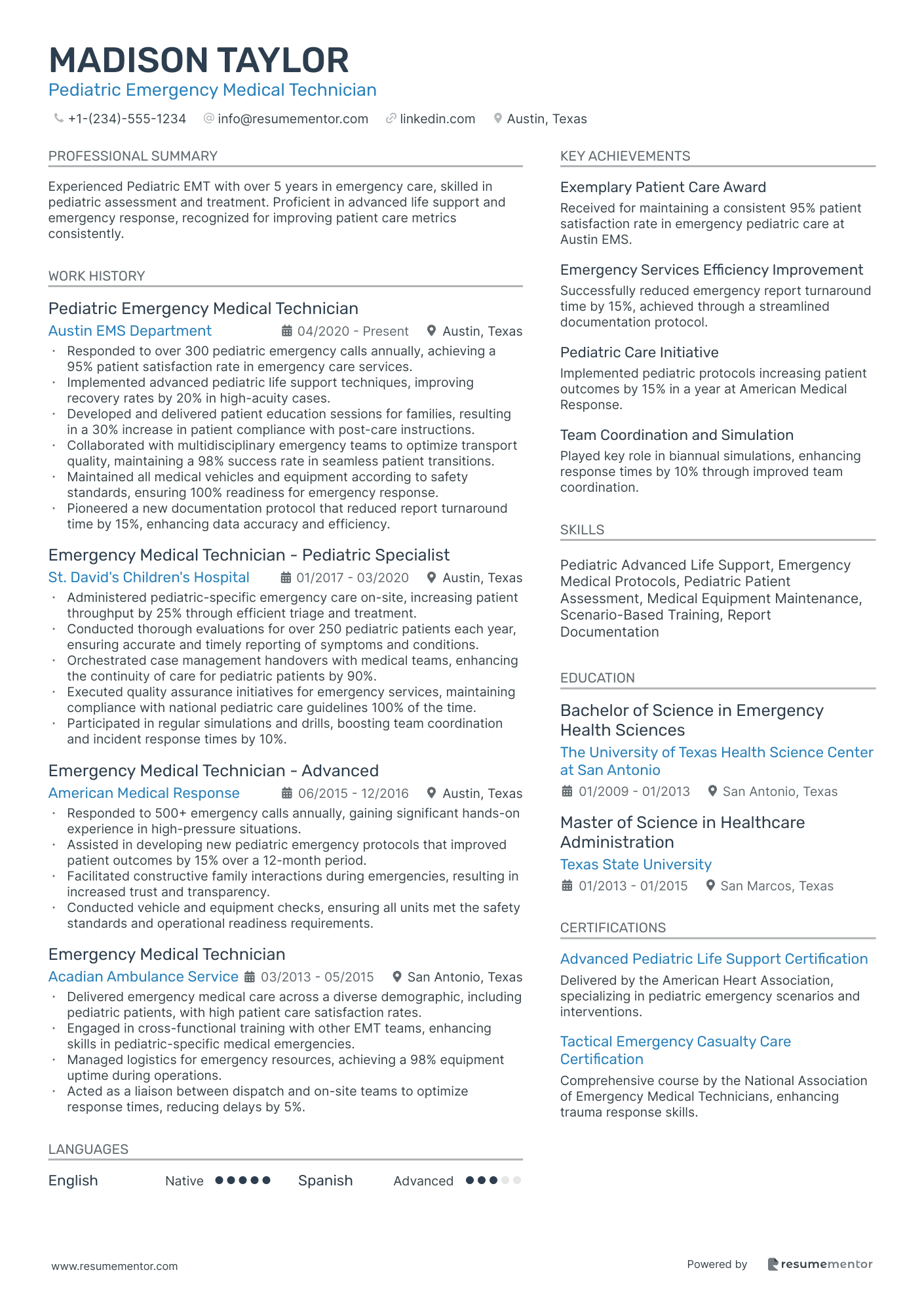
Pediatric Emergency Medical Technician
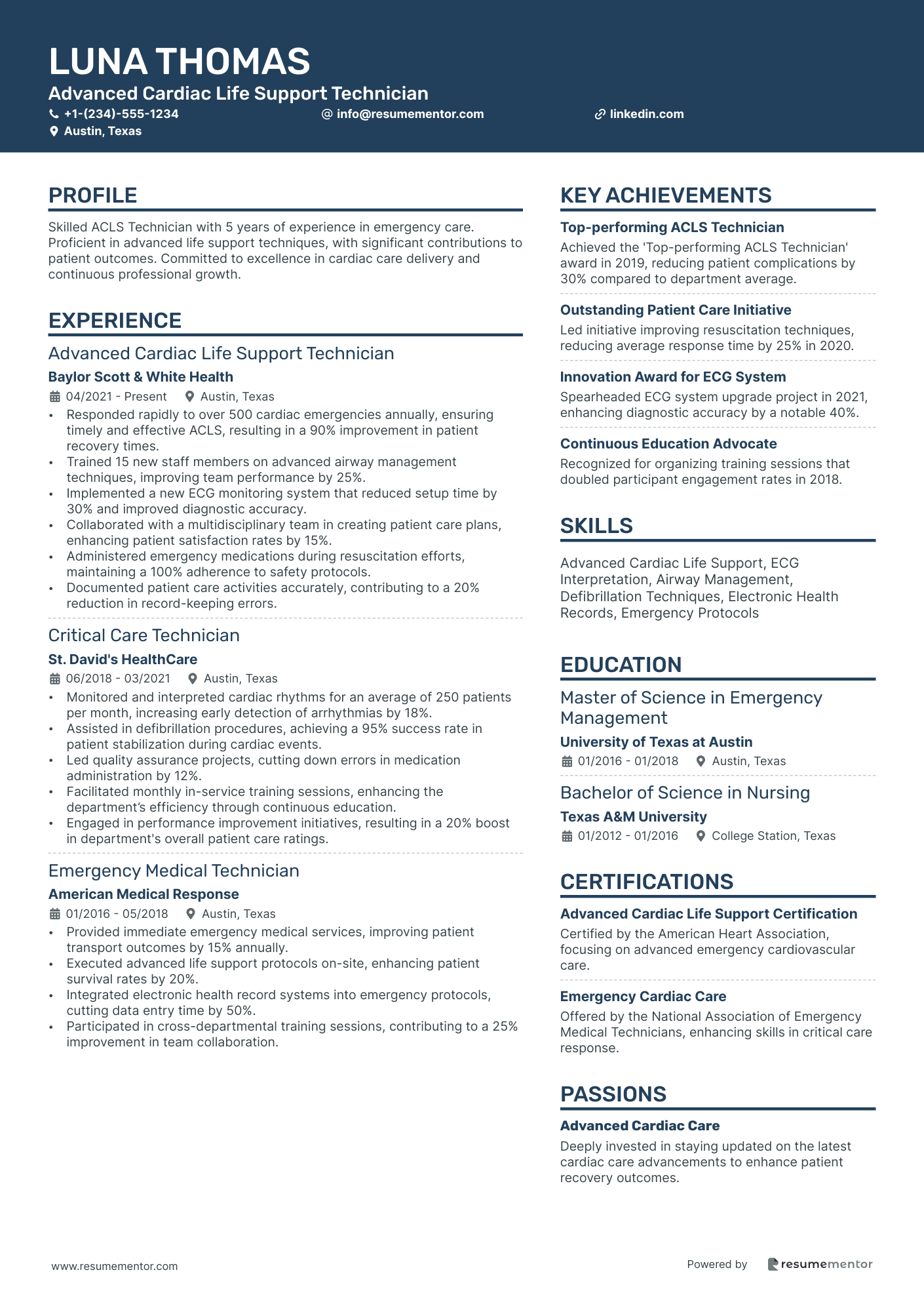
Advanced Cardiac Life Support Technician
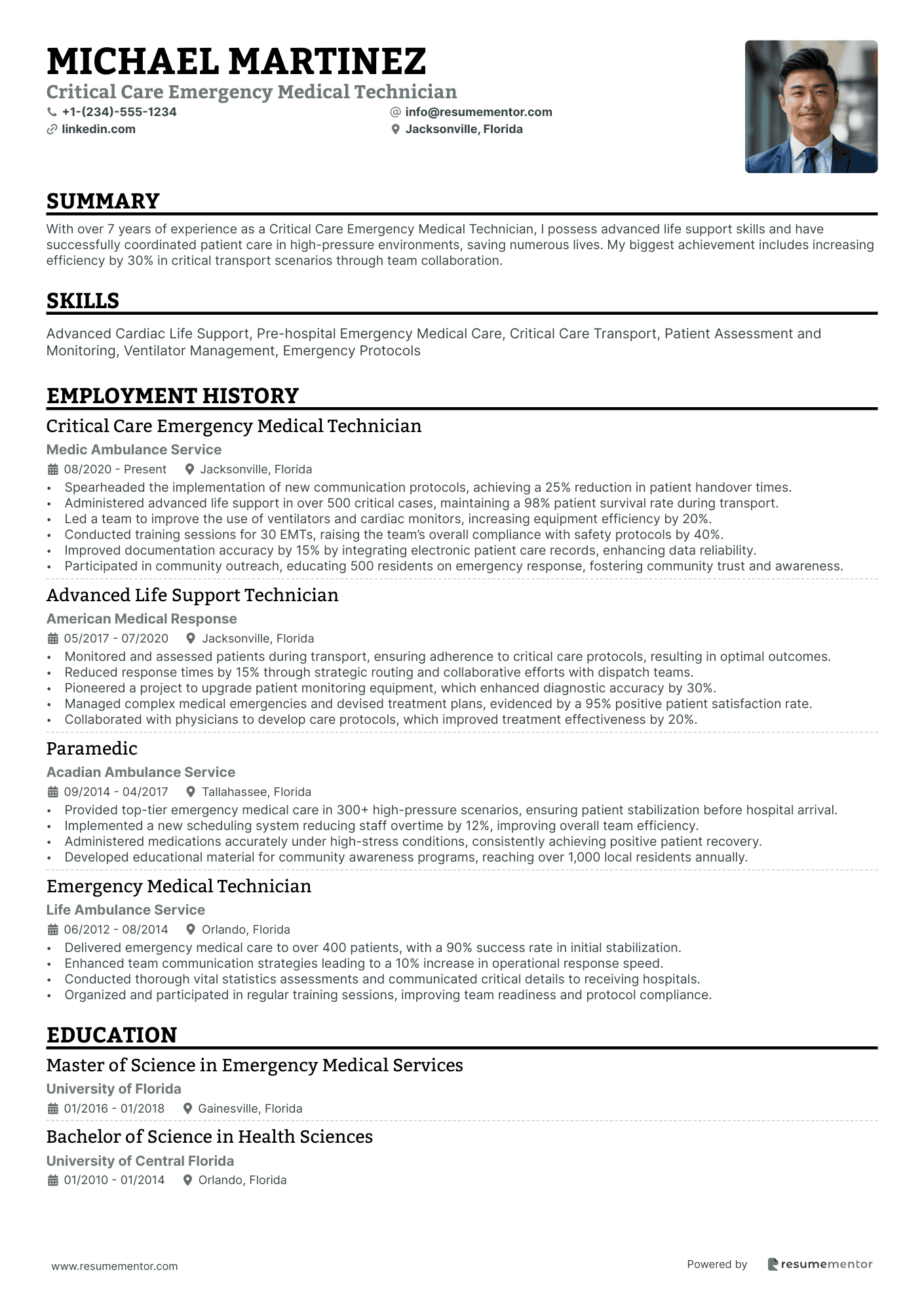
Critical Care Emergency Medical Technician
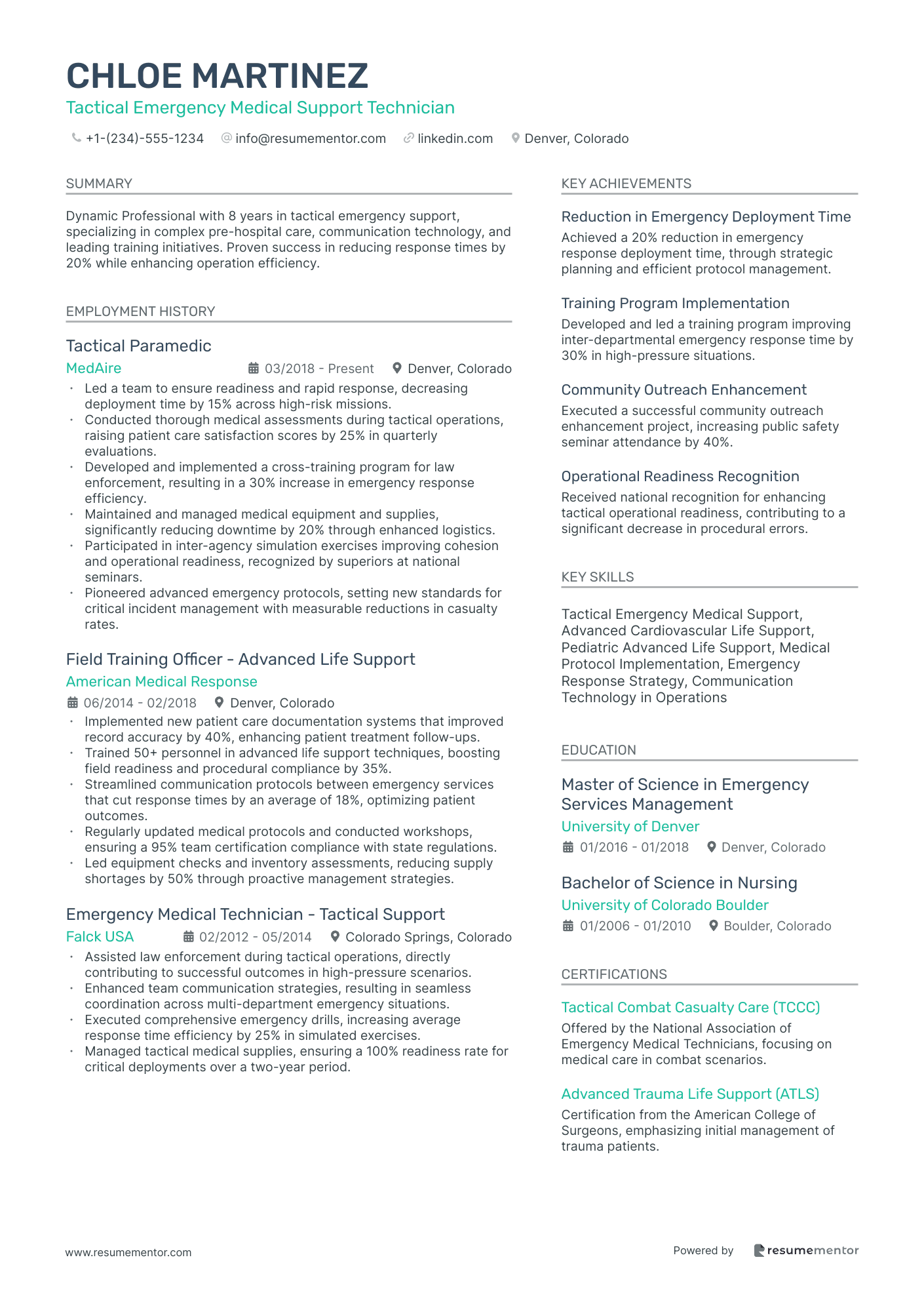
Tactical Emergency Medical Support Technician
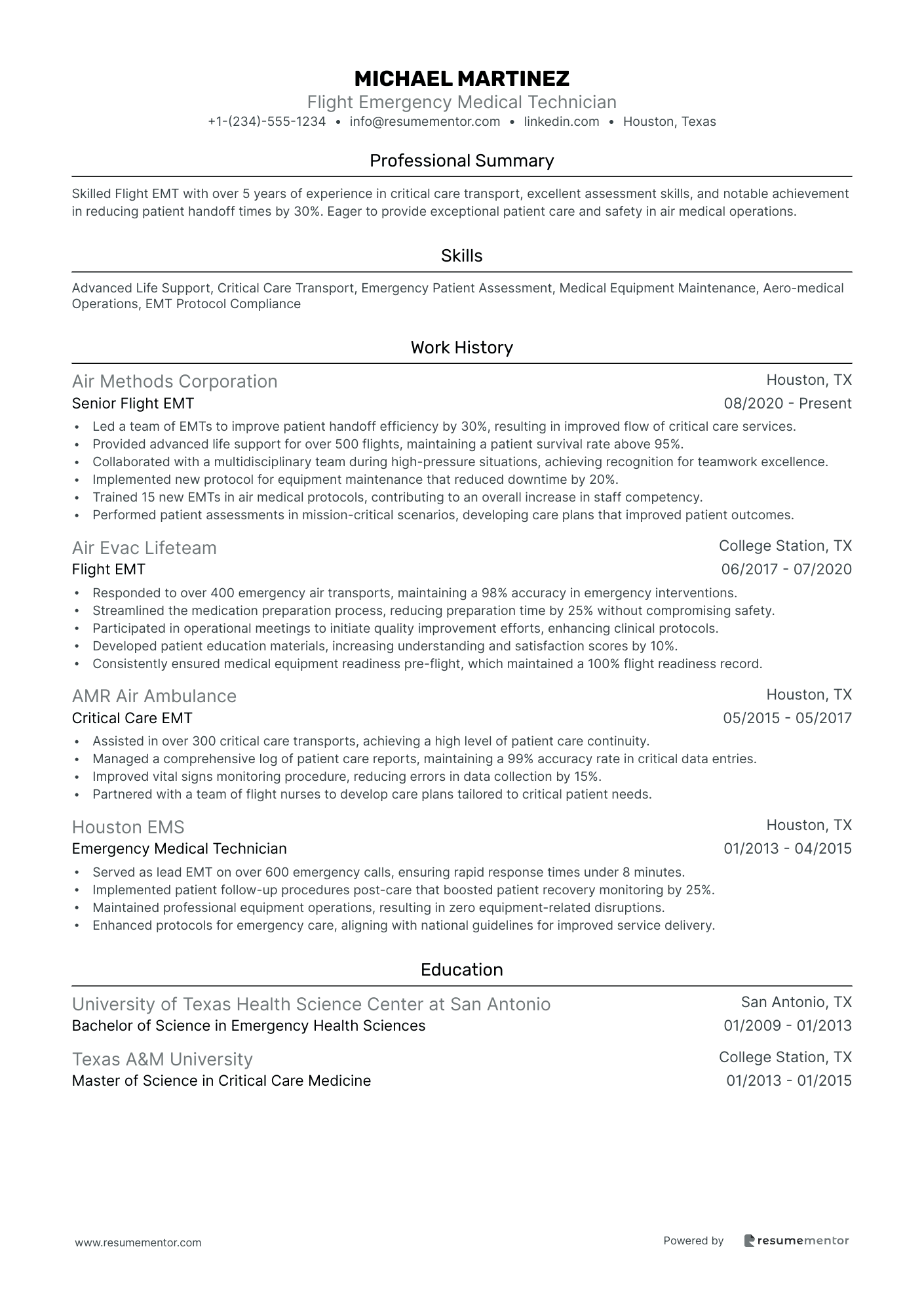
Flight Emergency Medical Technician
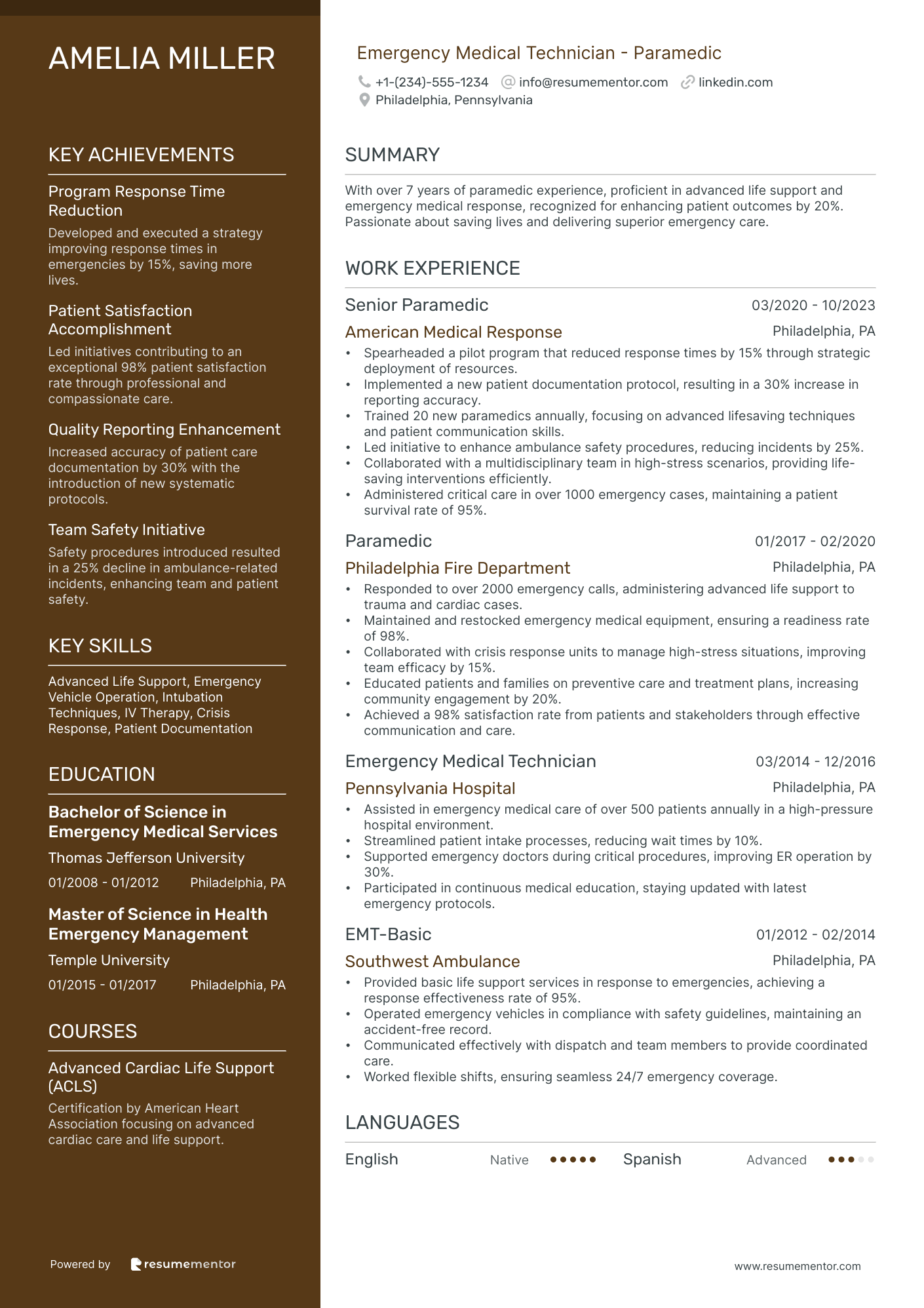
Emergency Medical Technician - Paramedic
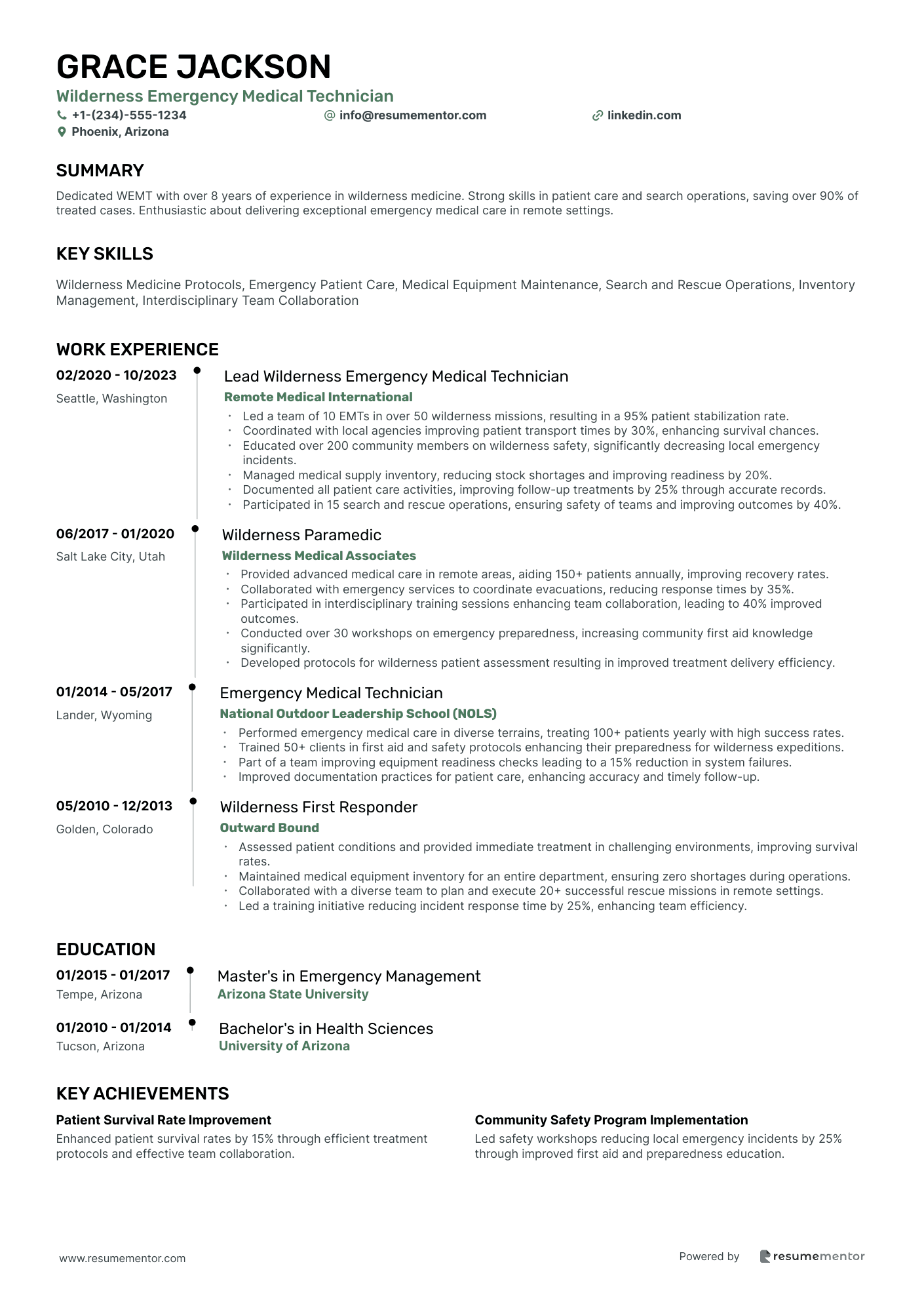
Wilderness Emergency Medical Technician
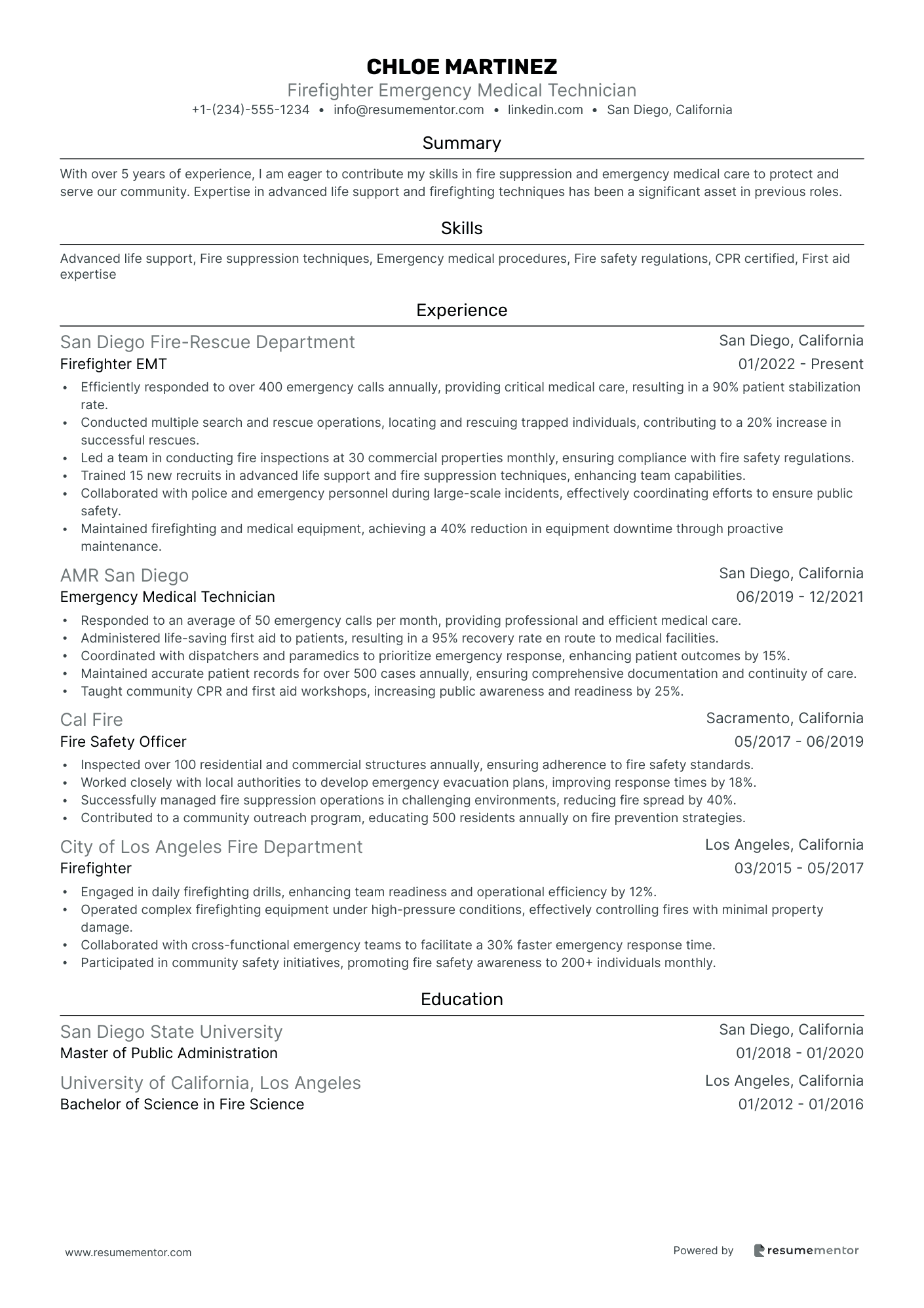
Firefighter Emergency Medical Technician
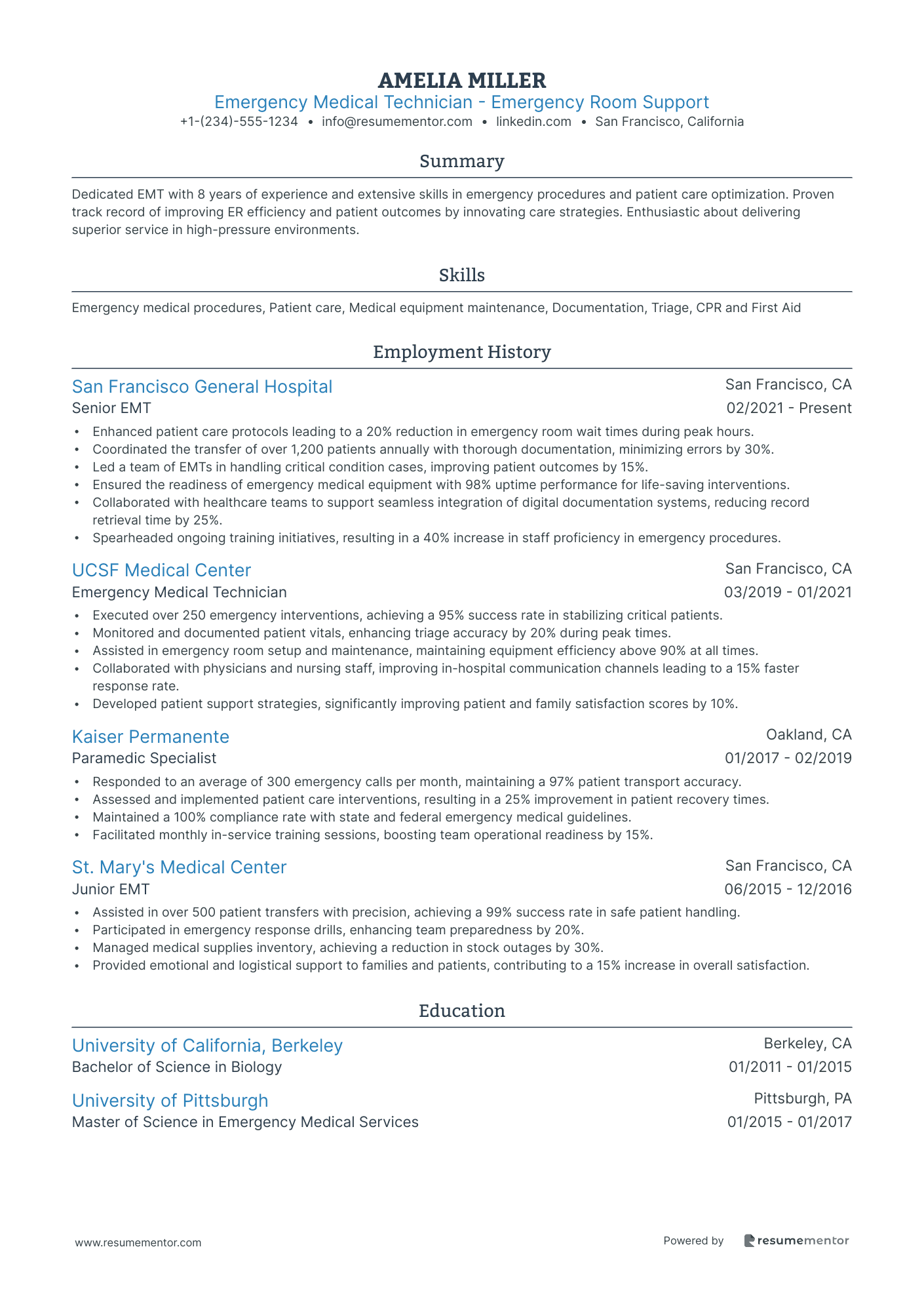
Emergency Medical Technician - Emergency Room Support
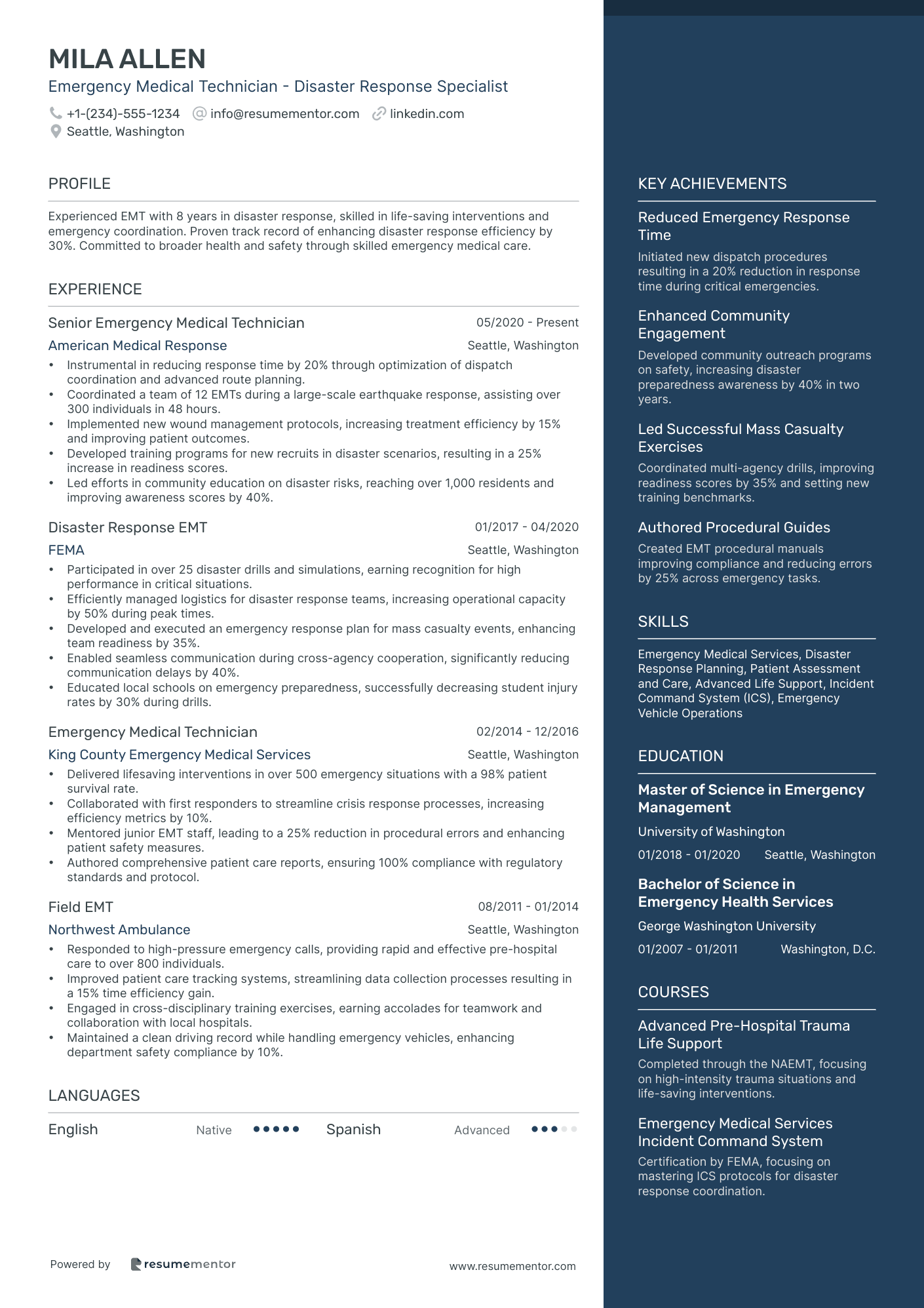
Emergency Medical Technician - Disaster Response Specialist

Pediatric Emergency Medical Technician resume sample
- •Responded to over 300 pediatric emergency calls annually, achieving a 95% patient satisfaction rate in emergency care services.
- •Implemented advanced pediatric life support techniques, improving recovery rates by 20% in high-acuity cases.
- •Developed and delivered patient education sessions for families, resulting in a 30% increase in patient compliance with post-care instructions.
- •Collaborated with multidisciplinary emergency teams to optimize transport quality, maintaining a 98% success rate in seamless patient transitions.
- •Maintained all medical vehicles and equipment according to safety standards, ensuring 100% readiness for emergency response.
- •Pioneered a new documentation protocol that reduced report turnaround time by 15%, enhancing data accuracy and efficiency.
- •Administered pediatric-specific emergency care on-site, increasing patient throughput by 25% through efficient triage and treatment.
- •Conducted thorough evaluations for over 250 pediatric patients each year, ensuring accurate and timely reporting of symptoms and conditions.
- •Orchestrated case management handovers with medical teams, enhancing the continuity of care for pediatric patients by 90%.
- •Executed quality assurance initiatives for emergency services, maintaining compliance with national pediatric care guidelines 100% of the time.
- •Participated in regular simulations and drills, boosting team coordination and incident response times by 10%.
- •Responded to 500+ emergency calls annually, gaining significant hands-on experience in high-pressure situations.
- •Assisted in developing new pediatric emergency protocols that improved patient outcomes by 15% over a 12-month period.
- •Facilitated constructive family interactions during emergencies, resulting in increased trust and transparency.
- •Conducted vehicle and equipment checks, ensuring all units met the safety standards and operational readiness requirements.
- •Delivered emergency medical care across a diverse demographic, including pediatric patients, with high patient care satisfaction rates.
- •Engaged in cross-functional training with other EMT teams, enhancing skills in pediatric-specific medical emergencies.
- •Managed logistics for emergency resources, achieving a 98% equipment uptime during operations.
- •Acted as a liaison between dispatch and on-site teams to optimize response times, reducing delays by 5%.
Advanced Cardiac Life Support Technician resume sample
- •Responded rapidly to over 500 cardiac emergencies annually, ensuring timely and effective ACLS, resulting in a 90% improvement in patient recovery times.
- •Trained 15 new staff members on advanced airway management techniques, improving team performance by 25%.
- •Implemented a new ECG monitoring system that reduced setup time by 30% and improved diagnostic accuracy.
- •Collaborated with a multidisciplinary team in creating patient care plans, enhancing patient satisfaction rates by 15%.
- •Administered emergency medications during resuscitation efforts, maintaining a 100% adherence to safety protocols.
- •Documented patient care activities accurately, contributing to a 20% reduction in record-keeping errors.
- •Monitored and interpreted cardiac rhythms for an average of 250 patients per month, increasing early detection of arrhythmias by 18%.
- •Assisted in defibrillation procedures, achieving a 95% success rate in patient stabilization during cardiac events.
- •Led quality assurance projects, cutting down errors in medication administration by 12%.
- •Facilitated monthly in-service training sessions, enhancing the department’s efficiency through continuous education.
- •Engaged in performance improvement initiatives, resulting in a 20% boost in department's overall patient care ratings.
- •Provided immediate emergency medical services, improving patient transport outcomes by 15% annually.
- •Executed advanced life support protocols on-site, enhancing patient survival rates by 20%.
- •Integrated electronic health record systems into emergency protocols, cutting data entry time by 50%.
- •Participated in cross-departmental training sessions, contributing to a 25% improvement in team collaboration.
- •Supported nursing staff in patient care, increasing patient satisfaction scores by 12% within the first year.
- •Maintained emergency equipment, ensuring a 98% readiness rate for cardiac emergencies.
- •Documented patient interactions in EHR, improving the accuracy of hospital records by 10%.
- •Conducted regular safety drills, contributing to a 15% increase in department readiness for critical scenarios.
Critical Care Emergency Medical Technician resume sample
- •Spearheaded the implementation of new communication protocols, achieving a 25% reduction in patient handover times.
- •Administered advanced life support in over 500 critical cases, maintaining a 98% patient survival rate during transport.
- •Led a team to improve the use of ventilators and cardiac monitors, increasing equipment efficiency by 20%.
- •Conducted training sessions for 30 EMTs, raising the team’s overall compliance with safety protocols by 40%.
- •Improved documentation accuracy by 15% by integrating electronic patient care records, enhancing data reliability.
- •Participated in community outreach, educating 500 residents on emergency response, fostering community trust and awareness.
- •Monitored and assessed patients during transport, ensuring adherence to critical care protocols, resulting in optimal outcomes.
- •Reduced response times by 15% through strategic routing and collaborative efforts with dispatch teams.
- •Pioneered a project to upgrade patient monitoring equipment, which enhanced diagnostic accuracy by 30%.
- •Managed complex medical emergencies and devised treatment plans, evidenced by a 95% positive patient satisfaction rate.
- •Collaborated with physicians to develop care protocols, which improved treatment effectiveness by 20%.
- •Provided top-tier emergency medical care in 300+ high-pressure scenarios, ensuring patient stabilization before hospital arrival.
- •Implemented a new scheduling system reducing staff overtime by 12%, improving overall team efficiency.
- •Administered medications accurately under high-stress conditions, consistently achieving positive patient recovery.
- •Developed educational material for community awareness programs, reaching over 1,000 local residents annually.
- •Delivered emergency medical care to over 400 patients, with a 90% success rate in initial stabilization.
- •Enhanced team communication strategies leading to a 10% increase in operational response speed.
- •Conducted thorough vital statistics assessments and communicated critical details to receiving hospitals.
- •Organized and participated in regular training sessions, improving team readiness and protocol compliance.
Tactical Emergency Medical Support Technician resume sample
- •Led a team to ensure readiness and rapid response, decreasing deployment time by 15% across high-risk missions.
- •Conducted thorough medical assessments during tactical operations, raising patient care satisfaction scores by 25% in quarterly evaluations.
- •Developed and implemented a cross-training program for law enforcement, resulting in a 30% increase in emergency response efficiency.
- •Maintained and managed medical equipment and supplies, significantly reducing downtime by 20% through enhanced logistics.
- •Participated in inter-agency simulation exercises improving cohesion and operational readiness, recognized by superiors at national seminars.
- •Pioneered advanced emergency protocols, setting new standards for critical incident management with measurable reductions in casualty rates.
- •Implemented new patient care documentation systems that improved record accuracy by 40%, enhancing patient treatment follow-ups.
- •Trained 50+ personnel in advanced life support techniques, boosting field readiness and procedural compliance by 35%.
- •Streamlined communication protocols between emergency services that cut response times by an average of 18%, optimizing patient outcomes.
- •Regularly updated medical protocols and conducted workshops, ensuring a 95% team certification compliance with state regulations.
- •Led equipment checks and inventory assessments, reducing supply shortages by 50% through proactive management strategies.
- •Assisted law enforcement during tactical operations, directly contributing to successful outcomes in high-pressure scenarios.
- •Enhanced team communication strategies, resulting in seamless coordination across multi-department emergency situations.
- •Executed comprehensive emergency drills, increasing average response time efficiency by 25% in simulated exercises.
- •Managed tactical medical supplies, ensuring a 100% readiness rate for critical deployments over a two-year period.
- •Responded to emergency calls, delivering pre-hospital care that resulted in a 30% improvement in patient recovery times.
- •Maintained high standards of care and compliance with medical protocols, contributing to zero violations in annual audits.
- •Collaborated on special initiatives to improve community outreach, increasing public engagement in health seminars by 40%.
- •Regularly updated knowledge on latest medical technologies, ensuring competitive edge in emergency medical support services.
Flight Emergency Medical Technician resume sample
- •Led a team of EMTs to improve patient handoff efficiency by 30%, resulting in improved flow of critical care services.
- •Provided advanced life support for over 500 flights, maintaining a patient survival rate above 95%.
- •Collaborated with a multidisciplinary team during high-pressure situations, achieving recognition for teamwork excellence.
- •Implemented new protocol for equipment maintenance that reduced downtime by 20%.
- •Trained 15 new EMTs in air medical protocols, contributing to an overall increase in staff competency.
- •Performed patient assessments in mission-critical scenarios, developing care plans that improved patient outcomes.
- •Responded to over 400 emergency air transports, maintaining a 98% accuracy in emergency interventions.
- •Streamlined the medication preparation process, reducing preparation time by 25% without compromising safety.
- •Participated in operational meetings to initiate quality improvement efforts, enhancing clinical protocols.
- •Developed patient education materials, increasing understanding and satisfaction scores by 10%.
- •Consistently ensured medical equipment readiness pre-flight, which maintained a 100% flight readiness record.
- •Assisted in over 300 critical care transports, achieving a high level of patient care continuity.
- •Managed a comprehensive log of patient care reports, maintaining a 99% accuracy rate in critical data entries.
- •Improved vital signs monitoring procedure, reducing errors in data collection by 15%.
- •Partnered with a team of flight nurses to develop care plans tailored to critical patient needs.
- •Served as lead EMT on over 600 emergency calls, ensuring rapid response times under 8 minutes.
- •Implemented patient follow-up procedures post-care that boosted patient recovery monitoring by 25%.
- •Maintained professional equipment operations, resulting in zero equipment-related disruptions.
- •Enhanced protocols for emergency care, aligning with national guidelines for improved service delivery.
Emergency Medical Technician - Paramedic resume sample
- •Spearheaded a pilot program that reduced response times by 15% through strategic deployment of resources.
- •Implemented a new patient documentation protocol, resulting in a 30% increase in reporting accuracy.
- •Trained 20 new paramedics annually, focusing on advanced lifesaving techniques and patient communication skills.
- •Led initiative to enhance ambulance safety procedures, reducing incidents by 25%.
- •Collaborated with a multidisciplinary team in high-stress scenarios, providing life-saving interventions efficiently.
- •Administered critical care in over 1000 emergency cases, maintaining a patient survival rate of 95%.
- •Responded to over 2000 emergency calls, administering advanced life support to trauma and cardiac cases.
- •Maintained and restocked emergency medical equipment, ensuring a readiness rate of 98%.
- •Collaborated with crisis response units to manage high-stress situations, improving team efficacy by 15%.
- •Educated patients and families on preventive care and treatment plans, increasing community engagement by 20%.
- •Achieved a 98% satisfaction rate from patients and stakeholders through effective communication and care.
- •Assisted in emergency medical care of over 500 patients annually in a high-pressure hospital environment.
- •Streamlined patient intake processes, reducing wait times by 10%.
- •Supported emergency doctors during critical procedures, improving ER operation by 30%.
- •Participated in continuous medical education, staying updated with latest emergency protocols.
- •Provided basic life support services in response to emergencies, achieving a response effectiveness rate of 95%.
- •Operated emergency vehicles in compliance with safety guidelines, maintaining an accident-free record.
- •Communicated effectively with dispatch and team members to provide coordinated care.
- •Worked flexible shifts, ensuring seamless 24/7 emergency coverage.
Wilderness Emergency Medical Technician resume sample
- •Led a team of 10 EMTs in over 50 wilderness missions, resulting in a 95% patient stabilization rate.
- •Coordinated with local agencies improving patient transport times by 30%, enhancing survival chances.
- •Educated over 200 community members on wilderness safety, significantly decreasing local emergency incidents.
- •Managed medical supply inventory, reducing stock shortages and improving readiness by 20%.
- •Documented all patient care activities, improving follow-up treatments by 25% through accurate records.
- •Participated in 15 search and rescue operations, ensuring safety of teams and improving outcomes by 40%.
- •Provided advanced medical care in remote areas, aiding 150+ patients annually, improving recovery rates.
- •Collaborated with emergency services to coordinate evacuations, reducing response times by 35%.
- •Participated in interdisciplinary training sessions enhancing team collaboration, leading to 40% improved outcomes.
- •Conducted over 30 workshops on emergency preparedness, increasing community first aid knowledge significantly.
- •Developed protocols for wilderness patient assessment resulting in improved treatment delivery efficiency.
- •Performed emergency medical care in diverse terrains, treating 100+ patients yearly with high success rates.
- •Trained 50+ clients in first aid and safety protocols enhancing their preparedness for wilderness expeditions.
- •Part of a team improving equipment readiness checks leading to a 15% reduction in system failures.
- •Improved documentation practices for patient care, enhancing accuracy and timely follow-up.
- •Assessed patient conditions and provided immediate treatment in challenging environments, improving survival rates.
- •Maintained medical equipment inventory for an entire department, ensuring zero shortages during operations.
- •Collaborated with a diverse team to plan and execute 20+ successful rescue missions in remote settings.
- •Led a training initiative reducing incident response time by 25%, enhancing team efficiency.
Firefighter Emergency Medical Technician resume sample
- •Efficiently responded to over 400 emergency calls annually, providing critical medical care, resulting in a 90% patient stabilization rate.
- •Conducted multiple search and rescue operations, locating and rescuing trapped individuals, contributing to a 20% increase in successful rescues.
- •Led a team in conducting fire inspections at 30 commercial properties monthly, ensuring compliance with fire safety regulations.
- •Trained 15 new recruits in advanced life support and fire suppression techniques, enhancing team capabilities.
- •Collaborated with police and emergency personnel during large-scale incidents, effectively coordinating efforts to ensure public safety.
- •Maintained firefighting and medical equipment, achieving a 40% reduction in equipment downtime through proactive maintenance.
- •Responded to an average of 50 emergency calls per month, providing professional and efficient medical care.
- •Administered life-saving first aid to patients, resulting in a 95% recovery rate en route to medical facilities.
- •Coordinated with dispatchers and paramedics to prioritize emergency response, enhancing patient outcomes by 15%.
- •Maintained accurate patient records for over 500 cases annually, ensuring comprehensive documentation and continuity of care.
- •Taught community CPR and first aid workshops, increasing public awareness and readiness by 25%.
- •Inspected over 100 residential and commercial structures annually, ensuring adherence to fire safety standards.
- •Worked closely with local authorities to develop emergency evacuation plans, improving response times by 18%.
- •Successfully managed fire suppression operations in challenging environments, reducing fire spread by 40%.
- •Contributed to a community outreach program, educating 500 residents annually on fire prevention strategies.
- •Engaged in daily firefighting drills, enhancing team readiness and operational efficiency by 12%.
- •Operated complex firefighting equipment under high-pressure conditions, effectively controlling fires with minimal property damage.
- •Collaborated with cross-functional emergency teams to facilitate a 30% faster emergency response time.
- •Participated in community safety initiatives, promoting fire safety awareness to 200+ individuals monthly.
Emergency Medical Technician - Emergency Room Support resume sample
- •Enhanced patient care protocols leading to a 20% reduction in emergency room wait times during peak hours.
- •Coordinated the transfer of over 1,200 patients annually with thorough documentation, minimizing errors by 30%.
- •Led a team of EMTs in handling critical condition cases, improving patient outcomes by 15%.
- •Ensured the readiness of emergency medical equipment with 98% uptime performance for life-saving interventions.
- •Collaborated with healthcare teams to support seamless integration of digital documentation systems, reducing record retrieval time by 25%.
- •Spearheaded ongoing training initiatives, resulting in a 40% increase in staff proficiency in emergency procedures.
- •Executed over 250 emergency interventions, achieving a 95% success rate in stabilizing critical patients.
- •Monitored and documented patient vitals, enhancing triage accuracy by 20% during peak times.
- •Assisted in emergency room setup and maintenance, maintaining equipment efficiency above 90% at all times.
- •Collaborated with physicians and nursing staff, improving in-hospital communication channels leading to a 15% faster response rate.
- •Developed patient support strategies, significantly improving patient and family satisfaction scores by 10%.
- •Responded to an average of 300 emergency calls per month, maintaining a 97% patient transport accuracy.
- •Assessed and implemented patient care interventions, resulting in a 25% improvement in patient recovery times.
- •Maintained a 100% compliance rate with state and federal emergency medical guidelines.
- •Facilitated monthly in-service training sessions, boosting team operational readiness by 15%.
- •Assisted in over 500 patient transfers with precision, achieving a 99% success rate in safe patient handling.
- •Participated in emergency response drills, enhancing team preparedness by 20%.
- •Managed medical supplies inventory, achieving a reduction in stock outages by 30%.
- •Provided emotional and logistical support to families and patients, contributing to a 15% increase in overall satisfaction.
Emergency Medical Technician - Disaster Response Specialist resume sample
- •Instrumental in reducing response time by 20% through optimization of dispatch coordination and advanced route planning.
- •Coordinated a team of 12 EMTs during a large-scale earthquake response, assisting over 300 individuals in 48 hours.
- •Implemented new wound management protocols, increasing treatment efficiency by 15% and improving patient outcomes.
- •Developed training programs for new recruits in disaster scenarios, resulting in a 25% increase in readiness scores.
- •Led efforts in community education on disaster risks, reaching over 1,000 residents and improving awareness scores by 40%.
- •Participated in over 25 disaster drills and simulations, earning recognition for high performance in critical situations.
- •Efficiently managed logistics for disaster response teams, increasing operational capacity by 50% during peak times.
- •Developed and executed an emergency response plan for mass casualty events, enhancing team readiness by 35%.
- •Enabled seamless communication during cross-agency cooperation, significantly reducing communication delays by 40%.
- •Educated local schools on emergency preparedness, successfully decreasing student injury rates by 30% during drills.
- •Delivered lifesaving interventions in over 500 emergency situations with a 98% patient survival rate.
- •Collaborated with first responders to streamline crisis response processes, increasing efficiency metrics by 10%.
- •Mentored junior EMT staff, leading to a 25% reduction in procedural errors and enhancing patient safety measures.
- •Authored comprehensive patient care reports, ensuring 100% compliance with regulatory standards and protocol.
- •Responded to high-pressure emergency calls, providing rapid and effective pre-hospital care to over 800 individuals.
- •Improved patient care tracking systems, streamlining data collection processes resulting in a 15% time efficiency gain.
- •Engaged in cross-disciplinary training exercises, earning accolades for teamwork and collaboration with local hospitals.
- •Maintained a clean driving record while handling emergency vehicles, enhancing department safety compliance by 10%.
Crafting a resume as an emergency medical technician (EMT) can feel like navigating through a complex emergency call, where every detail counts. Your resume is crucial for illustrating your life-saving skills, yet capturing your real-world experiences and technical expertise can be tricky. Highlighting your quick decision-making and hands-on abilities is essential to make an impact.
Starting with a resume template is like having a structured action plan—it provides the necessary framework to present your skills clearly. A resume template organizes your information in a way that's easy to follow, ensuring your qualifications stand out.
EMTs often face the challenge of putting their on-the-ground actions into powerful, descriptive words. Clearly conveying how your role influences high-stakes situations is key. By focusing on your accomplishments and core skills, you effectively communicate your uniqueness. Each part of your resume should make it easy for potential employers to see the value you add to their team.
With a focused strategy, you’ll create a resume that truly reflects your dedication and expertise in saving lives. Armed with the right tools and guidance, you can turn your passion for helping others into exciting new career opportunities.
Key Takeaways
- Focus on highlighting quick decision-making and hands-on abilities in your resume, clearly conveying how your role influences high-stakes situations.
- Use a structured resume template to present your skills clearly, ensuring your qualifications and accomplishments are easy to follow.
- Choose a resume format that suits your work history, like a chronological format for those with strong career progression, and always save it as a PDF to preserve formatting.
- Showcase both hard skills like medical equipment operation and soft skills like communication in dedicated sections, weaving them throughout the resume to align with job requirements.
- Include relevant education, certifications, and any additional sections like languages or volunteer work to provide a comprehensive view of your qualifications and dedication to the field.
What to focus on when writing your emergency medical technician resume
An emergency medical technician resume should effectively convey your readiness to handle critical situations with professionalism and skill. Each section needs to contribute to a comprehensive picture of your abilities, from your quick decision-making to your patient care expertise.
How to structure your emergency medical technician resume
- Contact Information: Your contact information should be prominent and accurate—ensure this includes your full name, up-to-date phone number, and a professional email address so employers can easily reach you.
- Professional Summary: This section is your chance to make a powerful first impression—briefly summarize your years of experience, key accomplishments in emergency medical response, and unique skills that set you apart, such as specialized training or unique patient care approaches.
- Certifications and Licenses: Highlighting your certifications is crucial—provide details about your CPR and EMT credentials, including any additional certifications like Advanced Cardiac Life Support, demonstrating how they equip you for challenges.
- Work Experience: Your experience section should tell a story of your professional growth—detail recent roles and responsibilities, emphasizing response times and critical incidents managed, and illustrate your teamwork and problem-solving capabilities.
- Skills: List critical skills that are intrinsic to effective EMT practice, ensuring to cover trauma response, rapid patient stabilization techniques, and proficiency with medical equipment—these underscore your technical competence in urgent scenarios.
- Education: Share your educational background as a solid foundation for your skills—mention your EMT training programs, including where and what you studied, to demonstrate your preparedness for this line of work.
Crafting a resume that communicates all these aspects effectively requires the right format, and below we’ll delve into each section more in-depth.
Which resume format to choose
Creating a standout emergency medical technician resume can make a significant difference in landing your next job. Start with a format that suits your experience; for those with a strong work history, a chronological format is ideal. It emphasizes your career progression and allows potential employers to easily track your development and expertise in the field. Choose modern fonts like Lato, Montserrat, or Raleway to give your resume a fresh and contemporary look without distracting from the content.
Once you have formatted your resume, always save it as a PDF. This choice is important because it preserves your formatting, ensuring that your resume looks the same on any device or platform, which is crucial when you want to present yourself as organized and professional.
Keep your margins at one inch all around to create a clean and organized appearance, which makes it easy for hiring managers to follow your information. Neat margins contribute to an approachable and polished layout, encouraging employers to read through your qualifications.
As you outline your skills and experience, use clear and straightforward language. This approach ensures that your key points stand out, making it easy for potential employers to see how well-suited you are to the emergency medical field. By thoughtfully combining these elements, you create a resume that's not only professional but also specifically tailored to the demands and expectations of the emergency medical technician role.
How to write a quantifiable resume experience section
The experience section of your emergency medical technician resume is your chance to highlight skills and achievements effectively. It should clearly focus on what you accomplished and how you made a difference. Start with your most recent job by using reverse chronological order to list your entries. Include experiences from the past 10-15 years, especially those relevant to an EMT role. Tailor your resume by closely analyzing the job description and weaving in tasks and outcomes that match the employer's needs. Strong action words like "delivered," "coordinated," and "implemented" help convey your impact and make your achievements stand out.
Tailoring is key, so make sure to align your past experiences with what the hiring company is looking for. When a job ad emphasizes handling high-pressure situations, detail examples where you excelled in similar conditions. By quantifying your achievements, you give clear evidence of your contributions, making it easy for employers to recognize your value. Presenting this information clearly ensures that your strengths are not just seen but understood.
- •Coordinated response to over 1,500 emergency calls each year, ensuring rapid and effective patient care.
- •Implemented a new patient triage system that sped up response times by 20%.
- •Led CPR and first aid training for 50 new recruits, boosting team readiness and safety.
- •Cut equipment downtime by 15% through regular maintenance and efficient inventory checks.
This EMT experience section effectively showcases how you excel in your role by connecting each achievement to a relevant skill. Highlights like managing over 1,500 calls a year and reducing equipment downtime by 15% provide clear evidence of your effectiveness and efficiency. Each bullet point is crafted to directly relate to skills valued by EMS employers, ensuring that your potential impact is clearly communicated. Using action verbs such as "coordinated" and "implemented" further ties your actions to results, painting you as a proactive and competent professional ready to handle any emergency. The smooth flow from one point to the next builds a cohesive narrative of your qualifications.
Technology-Focused resume experience section
A technology-focused EMT resume experience section should emphasize how your skills with equipment and digital tools make a real difference in emergency situations. Start by showcasing how you've used technology to improve patient care and streamline processes. Mention specific systems you are familiar with, like electronic patient care reporting systems, cardiopulmonary monitors, and everyday communication devices.
Next, bring your experience to life with examples of high-pressure situations where your tech skills truly mattered. By sharing how you effectively used equipment during emergencies to manage electronic records efficiently, you demonstrate your value. Each bullet point should be interconnected, showing how your mastery of systems led to achievements like reducing response times or successfully training your team on new technologies. This paints a clear picture for employers of the tangible benefits your tech-savvy approach brings to the table.
Emergency Medical Technician
City Hospital
June 2020 - Present
- Utilized electronic patient care reporting systems to document incidents accurately and efficiently.
- Operated advanced cardiopulmonary monitors to provide real-time data during emergencies.
- Reduced response times by 20% through effective use of GPS technology and routing tools.
- Trained fellow EMTs on the latest communication devices to enhance team coordination.
Training and Development Focused resume experience section
A training and development-focused EMT resume experience section should clearly outline your roles and achievements in training within the EMT field. Start by specifying your job titles and workplaces, along with accurate dates to map your professional timeline. Highlight your skills and accomplishments, particularly those related to training and development tasks that demonstrate your contributions. Use dynamic action verbs and quantifiable results to effectively convey the impact of your work.
When describing your responsibilities, emphasize any training initiatives you were part of, like mentoring new EMTs, crafting procedures, or enhancing safety measures. Ensure that you showcase any leadership positions you held, such as directing training sessions or improving training protocols. Keep your descriptions concise, ensuring they align closely with the training and development focus of your resume.
Senior EMT
Metro City Ambulance
January 2019 - Present
- Developed and implemented 5 new training protocols, boosting team efficiency.
- Led weekly training sessions for a team of 15 EMTs, resulting in quicker response times.
- Coached new hires, ensuring they followed safety regulations strictly.
- Introduced a feedback system that enhanced training session satisfaction by 20%.
Growth-Focused resume experience section
A growth-focused emergency medical technician (EMT) resume experience section should highlight the ways you've contributed to enhancing team performance and patient outcomes. Focus on specific actions you've taken that led to improvements, such as better patient care or more efficient emergency response processes. Use numbers and detailed examples to make your achievements clear and compelling. Each bullet point should weave together your personal growth with the positive changes you've helped implement at your workplace.
When reflecting on your past positions, identify key responsibilities and successes that demonstrate your ability to drive improvements. Consider the initiatives you've led, how you've enhanced response times, or how you've empowered colleagues by sharing your knowledge. Clearly laying out what you've accomplished illustrates why you're an asset to any team. By emphasizing growth-driven achievements, you'll effectively communicate your potential to foster positive transformations in future EMT roles.
Emergency Medical Technician
City Ambulance Services
June 2018 - August 2022
- Improved patient transport times by 15% by optimizing route plans and collaborating with dispatch teams.
- Led training sessions for newly hired EMTs, enhancing their readiness and performance on emergency calls.
- Worked closely with hospital staff to improve handoff communication, resulting in a 20% reduction in information errors.
- Developed a mentorship program that increased team efficiency by 10% by pairing new EMTs with experienced mentors.
Project-Focused resume experience section
A project-focused EMT resume experience section should clearly highlight the specific projects and achievements that demonstrate your abilities in emergency medical settings. By illustrating how you've enhanced processes, effectively responded to emergencies, or led initiatives that benefited patients and your team, you can create a compelling narrative. Use strong action verbs and quantify your successes where possible to vividly convey the impact you've made. This approach ensures your experience section is immediately engaging and informative.
Begin by listing your most recent or relevant role as an EMT, then seamlessly transition into specific projects or situations where you applied your expertise. Bullet points are useful for clarity, and each should start with an active verb to emphasize your role. You might describe implementing a digital patient documentation system that cut error rates and improved communication, leading a successful team response to a multi-casualty incident, running workshops that boosted recruit training efficiency, or collaborating on initiatives to streamline patient handovers. These examples should clearly tie back to your skills and highlight the tangible benefits of your work.
Senior EMT
City Ambulance Service
June 2020 - Present
- Implemented a digital patient documentation system, cutting error rates by 15% and enhancing team communication.
- Led a team of 5 during a high-pressure, multi-casualty incident, ensuring timely medical aid for all involved.
- Developed and facilitated training workshops for 20 new EMT recruits, increasing onboarding efficiency by 25%.
- Worked with local hospitals to streamline patient handover processes, reducing average transfer time by 10 minutes.
Write your emergency medical technician resume summary section
A skills-focused emergency medical technician resume summary should be designed to grab a hiring manager's attention right from the start. In 3-4 sentences, it should highlight your experience, expertise, and unique skills to showcase the value you bring. It's crucial to reflect on how you've positively impacted previous roles, and here's an example of how that can look for an EMT:
This summary works effectively by weaving together key EMT skills like patient assessment and quick decision-making, common traits that hiring managers look for. Highlighting these abilities with clear descriptions and strong action verbs helps to emphasize your achievements and strengths.
As you decide between crafting a summary or an objective, consider how much experience you have. A summary suits those with significant experience in the field, while a resume objective is more apt for individuals entering the field or making a career change. An objective focuses on your aspirations and how they align with the role you're applying for, emphasizing what you will bring to the company. Meanwhile, a resume profile is similar to a summary but typically shorter, focusing on career highlights. A summary of qualifications, on the other hand, presents a bullet-point list of key skills and accomplishments. Each of these options plays a different role in illustrating your professional journey and suitability for the position.
Listing your emergency medical technician skills on your resume
A skills-focused emergency medical technician resume should highlight the essential abilities that set you apart in handling emergencies. You can feature your skills in a dedicated section or integrate them throughout the resume in places like the experience or summary. The strengths you bring, often from soft skills like communication and teamwork, are personal traits that can enhance your performance in emergencies. Equally important are hard skills, such as CPR or defibrillator operation, which are teachable abilities critical for the job. Utilizing these skills and strengths as keywords will help ensure your resume stands out to hiring managers in the application process, aligning your experience with what employers seek.
For example, your skills section might look like this:
This skills section effectively highlights key competencies relevant to an EMT role. Each listed skill showcases specific technical expertise that employers need to see. The list's clear organization makes it easy to read and ensures your abilities match the job requirements.
Best hard skills to feature on your emergency medical technician resume
As an EMT, your hard skills should clearly demonstrate your ability to handle critical tasks during patient care and emergencies. These skills prove your competence in performing medical procedures safely and effectively, which is vital in high-pressure situations.
Hard Skills
- Patient assessment
- CPR and defibrillation
- Basic Life Support (BLS)
- Advanced Cardiac Life Support (ACLS)
- Trauma life support
- Intravenous therapy
- Airway management
- Medication administration
- Splinting and stabilization
- Use of medical technology
- Monitoring and recording vital signs
- Emergency vehicle operation
- Incident response
- Hazardous materials awareness
- Infection control procedures
Best soft skills to feature on your emergency medical technician resume
Soft skills for an EMT are crucial for interacting with people and managing challenging scenarios. These abilities show your capacity to communicate clearly, stay calm under pressure, and work effectively within a team, all of which are essential in emergency situations.
Soft Skills
- Communication
- Empathy
- Problem-solving
- Stress management
- Teamwork
- Attention to detail
- Decision-making
- Adaptability
- Compassion
- Interpersonal skills
- Reliability
- Conflict resolution
- Time management
- Resilience
- Critical thinking
How to include your education on your resume
The education section of your resume is an essential part of showcasing your qualifications for an Emergency Medical Technician (EMT) position. It's important to tailor this section, including only education relevant to the job. Omit any unrelated courses or degrees. If you have a high GPA, consider including it. Present your GPA like this: 3.8/4.0. Magma or summa cum laude honors should also be included, as it highlights your academic achievements.
When listing a degree, mention the specifics, such as "Associate of Applied Science in Emergency Medical Services." A poor example is one that lists unrelated education or lacks important details. Here's an example that doesn't meet standards:
This example is off because the degree doesn't relate to the EMT field. A strong example would look like:
This effective example presents a relevant degree, includes a solid GPA, and states the graduation dates clearly. It's concise yet comprehensive, revealing the right academic background for an EMT role.
How to include emergency medical technician certificates on your resume
Including a certificates section in your resume as an Emergency Medical Technician (EMT) is crucial. Certifications demonstrate your qualifications and dedication to the field. You can list the name of each certificate and include the date of issue next to it. Add the issuing organization to further validate your credentials. This section can even be placed in the header of your resume for prominence. For example, you could write: "EMT-Basic, National Registry of Emergency Medical Technicians (NREMT) - Issued 2023."
Here is an example of a well-structured certificates section that is relevant to an EMT:
This example is effective because it includes essential certifications for an EMT. The EMT-Basic certificate from the NREMT ensures you're qualified to provide emergency care. Showing the issuer builds trust and demonstrates authenticity. The CPR and AED certification from the American Heart Association highlights your life-saving skills. All these elements come together to show you're well-prepared for the role, making this section a vital part of your resume.
Extra sections to include on your emergency medical technician resume
As an emergency medical technician (EMT), showcasing your skills and experiences effectively on a resume can make a significant difference in advancing your career. Highlighting particular sections can help distinguish you as a well-rounded and qualified candidate. Here’s how you can include some impactful sections on your EMT resume.
- Language section — Demonstrate your ability to communicate with diverse patients by listing languages you speak, as this can be crucial in emergency contexts, especially in multilingual regions.
- Hobbies and interests section — Reflect your character and stress-management skills through hobbies like hiking or yoga, showing how you maintain a healthy work-life balance which is vital in high-stress roles.
- Volunteer work section — Emphasize your dedication to community service by detailing any medical-related volunteer experiences, which can reinforce your commitment to patient care beyond professional duties.
- Books section — Highlight your ongoing learning by mentioning books you've read related to emergency medicine or healthcare, indicating your passion for staying informed and improving your expertise.
These sections enhance your resume by giving employers a fuller picture of who you are, both professionally and personally, increasing your chances of standing out in a competitive job market.
In Conclusion
In conclusion, writing a compelling emergency medical technician (EMT) resume is much like responding to an urgent call—it's about being clear, focused, and impactful. Your resume should serve as a testament to your ability to handle high-pressure situations, showcasing not only your technical skills but also how your unique experiences contribute to the broader team. Remember, each section of your resume is an opportunity to reflect your dedication to saving lives and your readiness to tackle challenges. Whether you're highlighting certifications like CPR, listing relevant work experience, or including extra sections like languages and volunteer work, each part builds a comprehensive picture of your qualifications. By organizing your information with clarity and precision, potential employers can easily see the unique value you bring to the EMT field.
Investing time in selecting the correct resume format ensures your document is both eye-catching and professional. Keep your language straightforward and make sure your career achievements are emphasized using action-oriented descriptions. As you incorporate quantifiable results into your experience section, you make it easier for hiring managers to see your potential impact on their team. Finally, by tailoring each element to match the expectations of the EMT role, you enhance your chances of making a strong impression. Good luck as you build your career in this rewarding and challenging field, knowing that your resume is a vital tool in achieving your professional aspirations.
Related Articles
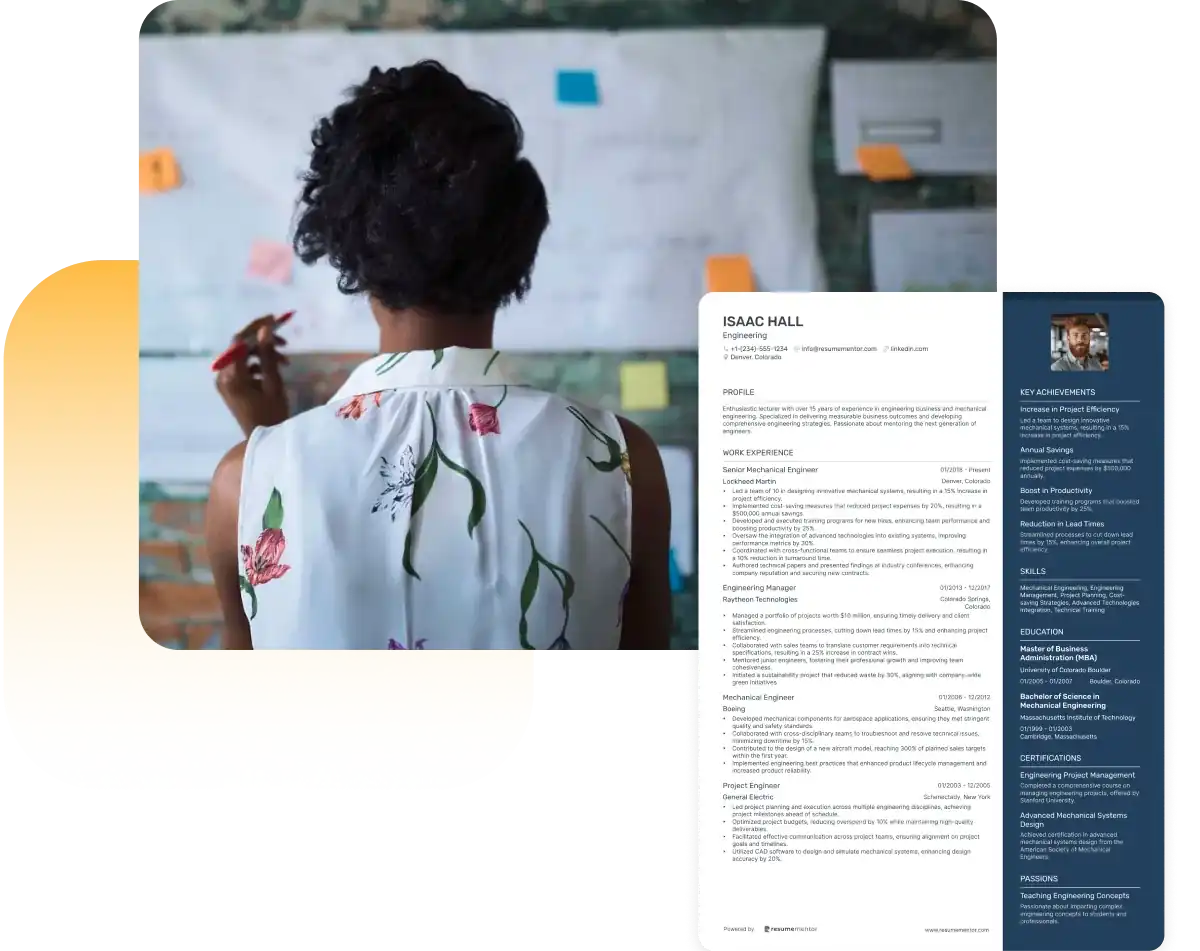
Continue Reading
Check more recommended readings to get the job of your dreams.
Resume
Resources
Tools
© 2025. All rights reserved.
Made with love by people who care.

